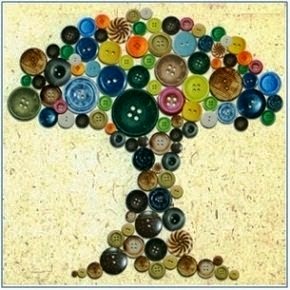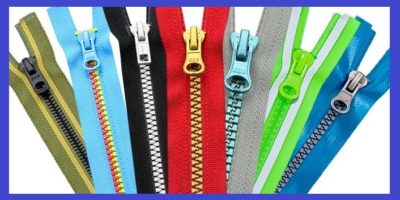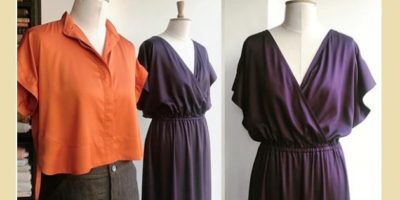Button, a small fastener, usually made of plastic and sometimes seashell, is used to fasten two pieces of fabrics in modern clothing and fashion design.


Buttons are probably the most important and popular closures used on fashion garments. They are simple, easy to use and cheaper attachments than zipper closure. Most buttons are round with two or four holes in the center and are attached to the garment. Paired with a buttonhole they form a closure.
Buttons may be of a variety of sizes, shapes, and colors. They may be flat, round, square, domed, concave, convex, so on and so forth. Some buttons may have a shape of toys, animals or any other shape to match with a certain style. Many buttons are produced with logos of the company to display a brand. Most of the buttons are manufactured on the mass scale to reduce cost. Some buttons are manually crafted with precious materials and are very costly. Most of the garments use buttons with matching color.
Button materials: Ligne is a French word which means ‘line’ and it is shortened with the letter of L. Internationally; ligne is used to recognize button size. Ligne is a liner unit (1/40 inch) used to measure the diameter of buttons. Buttons are made from three group’s materials:
(1) Plastic (2) Metals (3) Other natural materials such as stone, chalk, Shell,
leather, coconut, wood etc.
leather, coconut, wood etc.
Plastic buttons: Plastic buttons are cheaper than other button items. The demand of plastic buttons has been increased day by day after the first industrial revolution when mass people became more conscious of fashion. Plastic buttons are made from
polyester, nylon, melamine, urea etc. Polyester, urea, and melamine are thermos set plastics while nylon is thermoplastic. The first group once formed cannot be remolded for reprocessing. So during laundering or garment processing they do not get damaged. Garment and buttons are not dyed in the same dye-bath to match the color. It is an essential requirement that buttons must tolerate garment dyeing and
finishing without taking the dye themselves.
polyester, nylon, melamine, urea etc. Polyester, urea, and melamine are thermos set plastics while nylon is thermoplastic. The first group once formed cannot be remolded for reprocessing. So during laundering or garment processing they do not get damaged. Garment and buttons are not dyed in the same dye-bath to match the color. It is an essential requirement that buttons must tolerate garment dyeing and
finishing without taking the dye themselves.
Casting and molding processes make these buttons. Casting comprises pouring molten synthetic resin into a rotating drum and thus, sheets are formed. Blank sheets are cut to the shape of buttons, and holes are drilled into them. They are then polished to the desired smoothness. These casted buttons are relatively cheap. Molded buttons are produced either by compression molding or injection molding processes. Compression molding comprises pressing a mold into the soft molten resin to give it a shape of a button. In injection molding process, the soft resin is poured into a mold precisely of the shape of a smooth button. Injection molded buttons are relatively high priced.
Metallic Buttons: There is a good number of buttons which are made of the metallic essence. Tack buttons, snap buttons are examples. Metals that are used to manufacture buttons include silver, nickel, brass, copper, etc.
Snap buttons: These are metallic buttons. Snap buttons comprise paired mechanisms that are used as a closure. They are easier to close or pull open. So they can be opened and closed faster than buttons. Snaps are usually used on outerwear, casual wears and in many types of active wears. Many light jackets are found to use snap buttons. Some snap buttons are stamped with logos to display the brand or apparel company. Snap buttons can add aesthetic value to the garment.
Snap buttons include two parts:
(1) Attaching parts (2) Closing parts
Closing parts comprise a stud and a matching socket (see figure). Studs are connected to the garment and sockets are attached to the overlap. Sockets are a hollow part and contain a spring to grip the stud. An appropriate shape of the stud along with the spring lends holding the force of the closing unit. Attaching unit consists of (1) Eyelet or hollow rivet (2) Pronged ring and (3) Cap or top (see in the figure). Eyelet comprises a barrel and a cap. Pronged rings also called press fasteners are used for smaller snaps. They penetrate the fabric and are fixed to the closing unit. Snap buttons may be applied to the garments both manually and with automatic machines.
Tack buttons: These are strong metallic buttons. They find the frequent application on jeans front because of their longevity and strength. They have four parts shown in the figure. The cap is designed for aesthetic value and is often stamped with logo or brand to display the company. Tack buttons once attached cannot be taken out without damaging the button or cloth. Tack buttons are also used on jeans shirt, work wear, overalls etc. Buttons may make of other natural materials: Buttons are also made of other natural materials such as wood, stone, bone, horn, shell, rubber, glass, leather, coconut so on and so forth. Generally synthetic buttons are cheaper than natural buttons because procure of natural buttons raw materials is not easy, besides this to produce natural buttons manufacturers have to invest more money and time. Specially branded manufacturers may use natural buttons to produce their exclusive items.
Buttons may make of other natural materials: Buttons are also made of other natural materials such as wood, stone, bone, horn, shell, rubber, glass, leather, coconut so on and so forth. Usually, synthetic buttons are cheaper than natural buttons because procure of natural buttons raw materials is not easy, besides this to produce natural buttons manufacturers have to invest more money and time. Specially branded manufacturers may use natural buttons to create their exclusive items.
Buttons may make of other natural materials: Buttons are also made of other natural materials such as wood, stone, bone, horn, shell, rubber, glass, leather, coconut so on and so forth. Normally, synthetic buttons are cheaper than natural buttons because procure of natural buttons raw materials is not easy, besides this to produce natural buttons manufacturers have to invest more money and time. Specially branded manufacturers may use natural buttons to provide their exclusive items.
You may like: Leading Zipper Companies in the World




Leave a Reply
You must be logged in to post a comment.